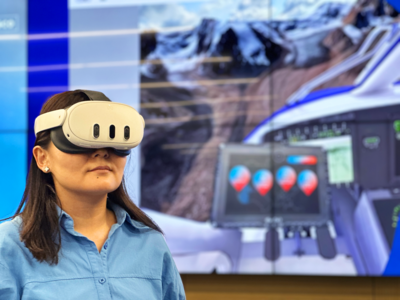Glacier Lifelines – The Future of Central Asia’s Water
An immersive virtual reality experience combining scientific findings and personal perspectives was developed under the leadership of the University of Zurich (UZH), with support from UNESCO. This project was carried out in close transdisciplinary collaboration with the Zurich University of the Arts (ZHdK), the Department of Knowledge Visualisation at the University of Fribourg (UniFR), and local actors from the five Central Asian countries. ‘Glacier Lifelines – The Future of Central Asia's Water’ takes visitors on an impressive journey into the future of water in Central Asia, showing how closely linked the lives of millions of people are to meltwater from glaciers.
Glacier Lifelines is an interactive virtual reality experience that immerses visitors in the fascinating but threatened world of Central Asia's glaciers. It shows how closely the meltwater from these glaciers is linked to the everyday lives of millions of people – from energy and agriculture to drinking water and security.
The VR experience begins spectacularly: in a helicopter flight over the Tuyuk-Su glacier in the Tien Shan mountains, participants experience the high alpine landscape with its glaciers, snowfields, and permafrost areas. Madina, the pilot, guides them through the scenes in a calm voice and shows how glacier water forms the backbone of Central Asia's water supply – and how this lifeline is increasingly threatened by the rapid retreat of the glaciers.
During the experience, users explore four key topics that affect all countries in Central Asia: reservoirs for energy and agriculture, natural hazards, irrigation systems, and glacier monitoring. They travel through the spectacular landscape of Central Asia and grapple with various questions and situations: How dependent are energy supply and agriculture on glacier meltwater? Where do the dangers of glacier retreat lie? How dependent is agriculture on functioning irrigation systems – and what can be done about it? And finally: How is data on glacier melt collected and how is it used? In the end, the central question remains: How will the future of water in Central Asia develop under the conditions of climate change – and what role can we play in this?
Glacier Lifelines is the first project of its kind to be carried out in close interdisciplinary and international cooperation. Commissioned and supported by UNESCO, an immersive VR experience was developed under the leadership of the University of Zurich (UZH) in close transdisciplinary collaboration with the Zurich University of the Arts (ZHdK), the University of Fribourg (UniFR), and local actors from the five Central Asian countries, combining scientific findings and personal perspectives. The aim is to make the importance of the cryosphere – i.e., glaciers, snow, and permafrost – as the lifeline of the region accessible to the general public and political decision-makers. Through intensive exchange, the use of local knowledge, on-site 360° image recordings, translations into several languages, and joint workshops, a lively, international project has been created that promotes dialogue, awareness, and a willingness to take action.
